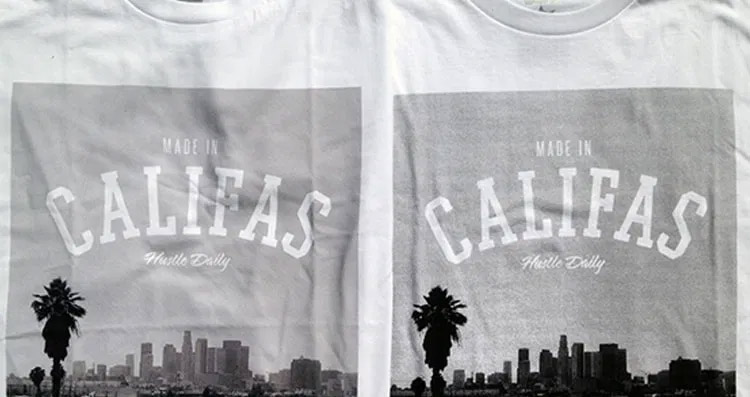Screen Printing vs. DTG Printing: Which is Best for Your Custom T-Shirts?

Screen Printing vs DTG Printing: The Printing Dilemma
Have you ever noticed why some custom t-shirts retain their color while others fade quickly? The printing method significantly impacts the longevity of colors, durability, and cost-efficiency. If you’re stuck choosing between Screen Printing vs DTG (Direct-to-Garment), you’re in good company—it’s a classic dilemma for anyone diving into custom apparel.
At Wanna Ink, we specialize in high-quality custom t-shirt printing. In this guide, we break down the key differences between Screen Printing vs DTG Printing, helping you choose the best method for your brand, business, or project.
What is Screen Printing? The Bulk Order Champion
Screen printing, also known as silk screen printing, is a time-tested method where ink is pushed through a mesh screen onto fabric. Each color gets its own screen, which makes Silk-Screen Printing vs DTG Printing a no-brainer for big runs but trickier for fancy, multi-color designs.
Advantages of Screen Printing
✅ Bold, Vibrant Colors – Thick ink application ensures rich, long-lasting prints that stand out on both light and dark fabrics.
✅ Highly Durable – Screen-printed designs resist fading and cracking, even after multiple washes.
✅ Economical for Large Orders – Lower cost per shirt when printing in bulk (50+ units).
✅ Works on Various Fabrics – Suitable for cotton, polyester, and blended fabrics.
Considerations
⚠ Not Ideal for Small Orders – High setup costs make small batches less cost-effective.
⚠ Limited Design Complexity – Each color requires a separate screen, making photorealistic or gradient-based designs challenging.
⚠ Time-Intensive Setup – Requires stencil creation, which increases lead time.
💡 Best Used For: Bulk printing, promotional t-shirts, corporate apparel, event merchandise, and sportswear.
What is DTG Printing? The Digital Solution for Small Orders
Direct-to-garment (DTG) printing is a modern digital printing method that works like an inkjet printer for fabric. Unlike screen printing, it prints directly onto the garment, allowing for intricate details and unlimited colors. When it comes to Screen Printing vs DTG Printing, this method’s all about flexibility and detail.
Advantages of DTG Printing
✅ Unlimited Colors & High Detail – Prints photorealistic images, gradients, and complex artwork with ease.
✅ Perfect for Small Orders – No setup costs make it ideal for one-off designs or limited runs.
✅ Soft to the Touch – Water-based ink soaks into the fabric, creating a smooth, lightweight feel.
✅ Eco-Friendly Printing – Uses water-based, non-toxic inks, reducing environmental impact.
Considerations
⚠ Less Vibrant on Dark Fabrics – Requires pre-treatment for dark garments to improve color depth.
⚠ Not as Durable as Screen Printing—DTG prints may fade faster over time, especially if they are not washed correctly.
⚠ Slower for Bulk Production – Since DTG prints each piece individually, large orders can take longer to fulfill.
💡 Best Used For: Limited-edition t-shirts, personalized apparel, photorealistic prints, and small-batch designs.
DTG vs. Screen Printing: A Side-by-Side Comparison
Is Screen Printing or DTG Better for Your Needs?
Choose Screen Printing If:
✔ You need 50+ t-shirts for a large event, business, or promotional campaign.
✔ Your design uses 1-3 solid colors with simple graphics.
✔ You're looking for long-lasting, fade-resistant prints.
✔ You want the most cost-effective method for bulk production.
Choose DTG Printing If:
✔ You need low-quantity or one-off prints.
✔ Your design contains intricate details, many colors, or photorealistic elements.
✔ You want a soft print feel rather than thick ink layers.
✔ You prefer an eco-friendly printing method with minimal waste.
FAQs: DTG Print vs Screen Print — What People Ask Before Choosing a Printing Method
Screen Printing is more durable as the ink sits on top of the fabric in thick layers, while DTG ink soaks into the fabric, making it more prone to fading over time.
Yes, but dark t-shirts require a pre-treatment process, and colors may not be as vibrant as screen printing.
For large orders, screen printing is much cheaper per unit. For small orders, DTG is more affordable since it requires no setup.
DTG is the best choice for small-batch, custom designs, as it offers unlimited colors without setup fees.
Conclusion: Screen Printing vs DTG Printing – Which One Wins?
Both Screen Printing and DTG Printing have unique advantages. Screen printing is the best choice for bulk orders, long-lasting durability, and simple, bold designs. At the same time, DTG is perfect for detailed, colorful artwork and small-batch printing.
🚀 Need custom-printed apparel? Wanna Ink offers both Screen Printing and DTG! Let's bring your design to life today. Contact us now for expert recommendations.


